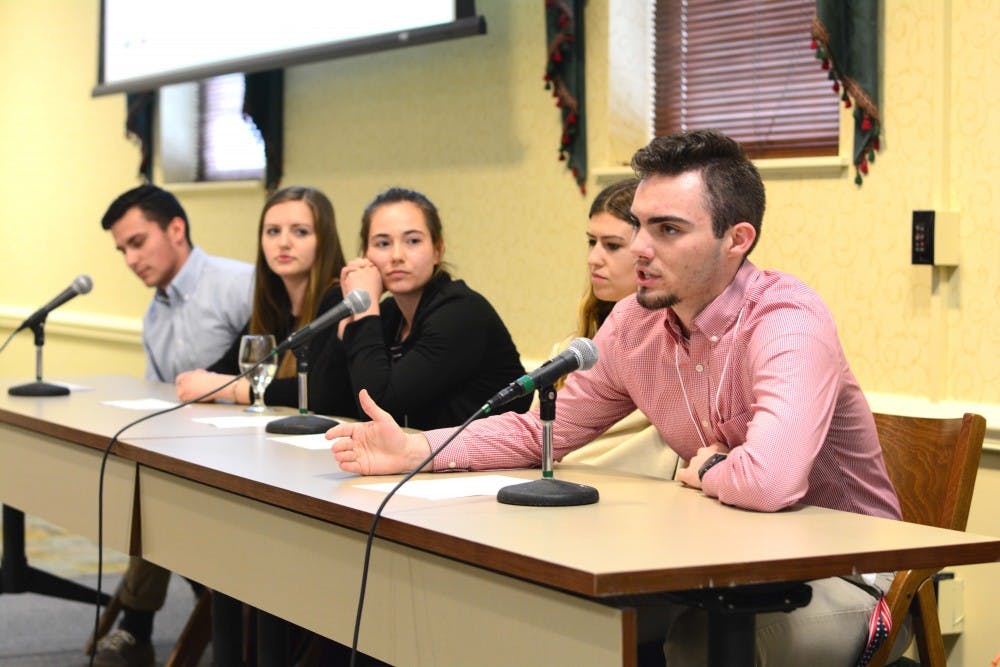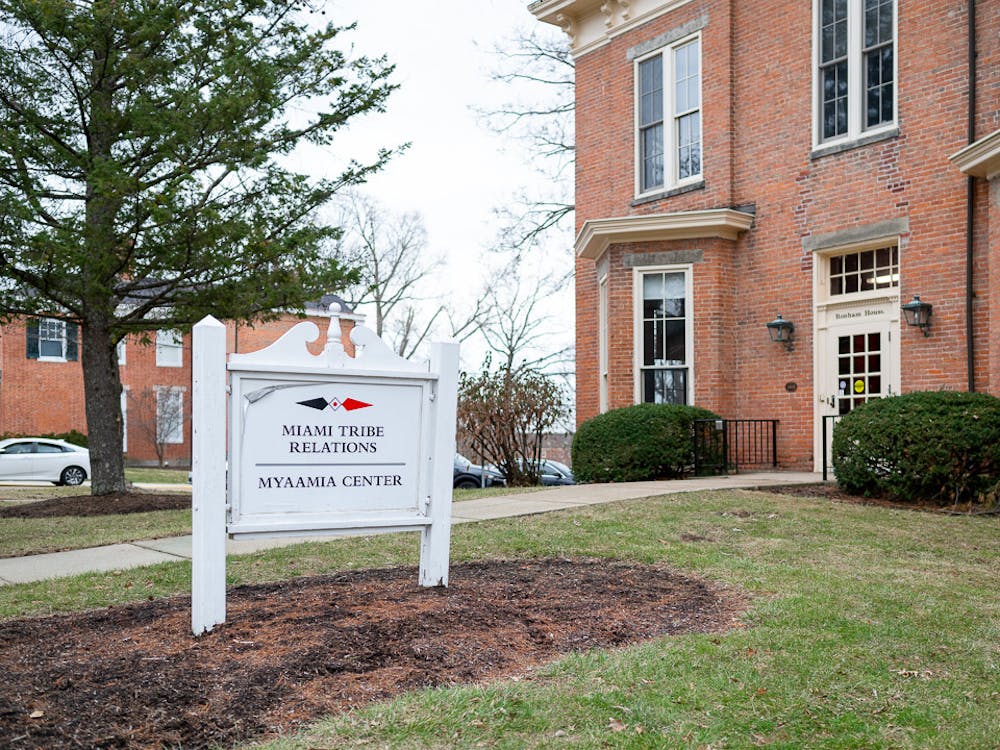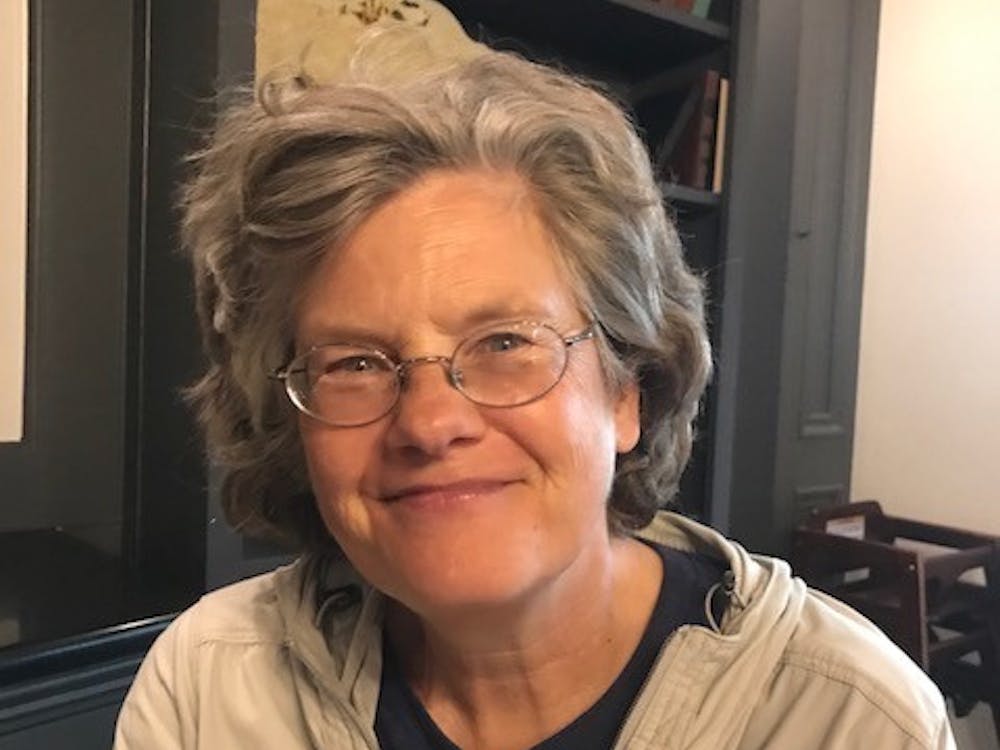Over 125 Miami Tribe members, Oxford leaders, university administrators and other attendees packed the Marcum Center last Friday for the eighth biennial Myaamiaki Conference.
Members of the university's Myaamia Center and other researchers offered up findings on the history, linguistics and childhood development of the Miami Tribe. Myaamia students spoke about their experiences at the university and a few vendors and artists displayed their handicrafts.
The Myaamia Center live-streamed the event on its Facebook page, where about 10 to 20 people were watching at any given time.
In his opening remarks, Daryl Baldwin, director of the Myaamia Center, commented on how much the tribe has learned and experienced in recent years and how if young members choose to continue engaging in their culture, it would increase the tribe's growth moving forward.
"For many years, there was a time when things were pretty tough in our community -- we were held together by strands," Baldwin said. "But, there were some elders and there were some community members that held onto those strands...and there is a younger generation that is now ready to pick those pieces up."
Chief Doug Lankford of the Miami Tribe also expressed optimism.
"Where is this gonna go? We just don't know," Lankford said. "All we have to do is water it and keep the weeds out...Our youth is going to carry this forward."
Tribe member Timothy McCoy gave the first presentation of the day, entitled "Using Beads Made from Meteorites to Learn about the Mound Builders."
Blind in one eye since childhood, McCoy spent much of his life looking at the earth below him as he walked. He grew up to become a geologist and learned to read a rock's history from its appearance.
"I don't see a pile of rocks," he said. "I see a pile of stories."
In his presentation, McCoy spoke about how the stories of the Myaamia people and their fellow Great Lakes tribes could be found in the rocks and other natural materials they left behind.
This included exotic objects made of galena, copper, mica, conch shells, obsidian and iron. None of these materials are naturally found in this area. In fact, the only naturally occurring iron that could be found was in meteorites.
Enjoy what you're reading?
Signup for our newsletter
This means the tribes of the region, including the Miami, must have either traded with each other and the other tribes, or they went out to gather the materials themselves, McCoy said.
Either way, it is proof that native peoples had complex societies with established trade systems and centers and advanced metalworking technology.
Haley Strass, a member of the Miami Tribe and frequent presenter at Myaamiaki Conferences, particularly enjoyed McCoy's presentation.
"I'm a psychologist by training, and so a lot of the questions I ask myself are kind of existential in nature...thinking about space and earth, and how they were formed and our place in that," she said. "I think the reason, historically, our people looked to those things was to explain our existence and that's exactly what Tim's talking about."
The second presentation was "The Western Rim of Fort Ancient Settlement and the Pre-Contact Origins of the Myaamia People," given by Stephen Warren. Although not a member of the tribe, Warren has done research related to Myaamia interests.
Warren discussed the Native American Grave Protection and Repatriation Act (NAGPRA), which requires human remains of native people must be returned to their tribes.
However, many researchers have been able to exploit this law by claiming the gap in historical record between pre- and post-removal tribes makes many remains "culturally unidentifiable." Warren presented evidence that showed natives still occupied their lands during that gap in the record.
"Essentially, the burden today for NAGPRA protections falls on modern tribes," Warren said. "If they are to make culturally unidentifiable objects identifiable, they have to do the necessary research... It's about protecting the human rights of Miami ancestors."
Warren was followed by Michael McCafferty, who presented "Symbolic Language in the Early Historic Miami-Illinois Dictionaries." McCafferty, who worked to translate dictionaries of the Myaamia language written by French Jesuit missionaries, explained a variety of Myaamia expressions and metaphors.
For example, the Myaamia phrase maciciipihkapita translates to "that which has taken root" or "he is lazy." Kyaamwa mahweewa means "the wolf is enraged" and refers to an argumentative person. Takaakani ayooro is spoken to someone who won't stop knocking on one's door and essentially means, "Use an ax!"
"Your ancestors were witty people and sometimes given to sarcasm," McCafferty said, drawing laughter from the crowd.
Amanda Buduris loved his presentation.
"I'm a language nerd," she said.
Neither Myaamia nor Miami student, Buduris attended the conference for the first time.
"I didn't really know what to expect, this being my first one," she said.
But, through McCafferty's explanation and others, she felt engaged despite not being part of the culture.
Fourth in the conference's lineup was "Understanding Indian Reserves," presented by Cameron Shriver and tribe member Doug Peconge.
Shriver ran through a brief history of how, through a series of treaties, Myaamia homelands were separated into individual and community reserves, and how those reserves were gradually sold off. Peconge explained that the development of a Graphical Information System (GIS) would allow tribe members and researchers to input information about the transfer and loss of lands.
"[GIS is] a narrative of land retention over time and a tool for Myaamia families to tell their own stories that I am not privy to," Shriver said.
The project resonated with Lauren Swaidner, a tribe member and Miami graduate whose family once owned reservation land in Indiana. Swaidner has been to multiple conferences before and always enjoys coming back.
"I live on a reservation now in South Dakota," she said, "so it's been really cool for me to take bits and pieces of what's going on here and bring it back there, or taking what I've learned there and bringing it here and...weaving the narrative of the story."
Next, tribe member Wesley Leonard presented "Decolonizing Linguistic Science Through Native American Participation."
Leonard spoke about Eurocentric ideas of how language works, and how it is understood. In his experience, these "colonial" viewpoints, when applied to Native American languages, do not fit how natives think of their own language. They decontextualize language from culture in a way that is alienating to natives for whom language is tied intimately to peoplehood. His proposed solution to this disconnect is to get more Native Americans involved in the field of linguistics.
The next presentation "wiikiaaminki neepwaankanki: Learning in the Home" brought a personal (and decidedly cute) note to the ongoing focus on language.
Kristina Fox, an assistant in the Myaamia Center's education and outreach office, and Jesse Seddelmeyer, director of saakaciweeta, one of the tribe's summer education programs, talked about childhood language development and the resources available for teaching myaamiaataweenki, the myaamia language, at home.
They also shared video and audio of their own children learning the language. One clip showed Seddelmeyer teaching numbers to her three-year-old daughter, Riley.
As her mom sings the single digits, Riley counts along on her fingers for a few measures before the exercise devolves into an impromptu game of patty-cake. A second video, filmed a week before the conference, shows a slightly-older Riley counting passing cars -- out loud -- from behind her living room window.
"She's missing a couple in there," said Seddelmeyer, to laughter from the room.
For those interested in picking up rudimentary myaamiaatawenki, the Myaamia Center YouTube channel has a playlist of 10 children's songs. The center is also working to update Niiki, an app that teaches household Myaamia words, for the latest versions of iOS and Android.
The final talk of the afternoon focused on the experience of Myaamia students at Miami University.
The panel of students was led by Kara Strass, a Myaamia student in the Student Affairs in Higher Education master's program who works with Myaamia Center, and Haley Strass, a Myaamia doctoral candidate at Iowa State who is interning at Miami University's Student Counseling Center next fall.
More than 120 Myaamia students have attended Miami since 1991, when the first three Myaamia students enrolled. In that time, 70 degrees have been awarded to Myaamia students and 30 currently study at the university.
Those who currently attend are recipients of the Myaamia Heritage Award program, which requires that students maintain full-time status, keep up their GPA and take a one-credit-hour heritage class all four years.
To the surprise of the five undergraduate students who participated in the panel, the heritage class has been a cornerstone experience, one that fosters Myaamia identity in a unique way.
"For me, I expected to go to Miami, focus on my biochemistry studies and kind of have to go to a class each week," said Myaamia junior Brandon Butcher. "In that class, I expected to learn about my heritage, kind of like history, but what I found was that it was more about community building, and I would say I'm definitely part of the community now -- it wasn't something I expected to learn."
arwinejk@miamioh.edu
evansjm4@miamioh.edu




